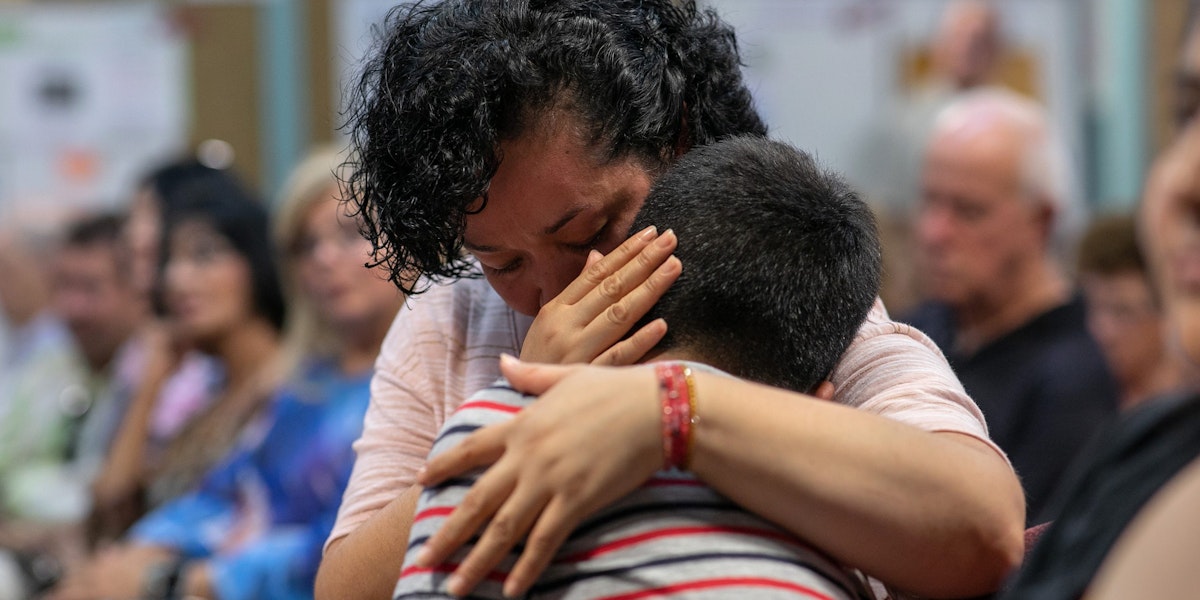This piece was originally published by Next100, a startup think tank powered by The Century Foundation and created for—and by—the next generation of policy leaders.
The picture that whistleblowers paint of U.S. immigration detention centers is a clear, stark, and dire one. Intentionally withholding personal protective equipment; holding people in freezing cells in order to lower their body temperatures and mask fever symptoms; hiring private contractors and hotels in order to block children’s access to procedural protections; violating women’s reproductive rights through forced sterilization: these are only a few of the measures the Trump administration has taken in their persecution of immigrants and asylum seekers. During this pandemic, there have been 3,780 confirmed cases of COVID-19 amongst detainees and 153 cases amongst Immigration and Customs Enforcement (ICE) employees. Thirteen deaths have been reported in adult detention centers since March, eight of which were directly related to COVID-19. However, there is evidence that ICE is undercounting the true impact of COVID-19 in their facilities.
These conditions cannot be noted enough, and at various moments have been much commented on; but what has received far too little attention is the compounding impact that the practices being used by the Department of Homeland Security (DHS) during the COVID-19 pandemic have had on health, particularly for children. What has resulted is a public health crisis for children of catastrophic proportions, one which, furthermore, is entirely avoidable. The administration’s practices have been unaligned with the expertise of public health professionals. Many of them have said jails, detention centers, and prisons are breeding grounds for COVID-19, and yet detention centers have only released a very small portion of their populations within the United States—despite the fact that they are clearly holding many more people who can be safely released under these circumstances, children and their families being chief among them.
In this moment, and always, we should be promoting and investing in public health on a monumental scale, especially as we consider the implications of this crisis for future generations. While undoubtedly the uncertainty of a global pandemic raises challenges for everyone, an effective government response grounded in public health can help minimize the traumatic impact of this trying time. The basic goal of public health is to promote and protect the health of people and their communities. This occurs by creating safe and healthy physical environments, and by understanding that the conditions of the environments in which people are born, live, and learn matter. As such, public health must be considered holistically, and cannot be siloed into simply thinking about access to health care and sanitary conditions. Other factors must be considered, including economic stability, education, social and community context, the built environment, and the protective factors in place.
It almost goes without saying that the government response to immigrants and asylum seekers within the context of the pandemic—which has included stripping children of the protective factors that allow them to deal with challenging situations—considers none of this. On the contrary, the current government response creates physically and psychologically unsafe and unhealthy environments for children and their families. That a public health disaster is underway in these detention centers is no surprise at all.
The criminal justice system and the immigrant detention system are intertwined and equally unjust in their treatment of children and families.
What our government is doing to our immigrant and refugee community will not only have an impact today and tomorrow, but on generations to come. The harms occurring are extensions of those perpetrated by the criminal justice system, and, together, they make up the intergenerational traumas of separation and incarceration for Black and Brown families in the United States. The criminal justice system and the immigrant detention system are intertwined and equally unjust in their treatment of children and families.
President-elect Biden must make good on his promise to reunite missing children with their parents within his first 100 days in office. But in addition, a new administration, working with Congress, has an opportunity and an obligation to swiftly and thoroughly counter these victimizations in longer-term ways—immediately. Advocates have outlined why children, whether as unaccompanied minors or as part of a family unit, have been made especially vulnerable by immigration policy targeting family members and caregivers, pandemic or not—but especially now. In this report, we lay out the current context and how it adds up to the public health crisis immigrant children now face; then, we offer a set of policy recommendations that will address the immediate needs of those most vulnerable children who have been so violently impacted by immigration policy and also correct the policy framework overall to prevent such a disaster ever happening again. These recommendations include the following:
-
- Stop the unjust detention and deportation of immigrants and asylum seekers by:
-
- stopping the promotion of “deterrence” strategies and restoring asylum;
- refusing to separate families and immediately looking for safe alternatives within the United States; and
- ensuring due process and fair outcomes through universal legal representation.
-
- Stop the unjust detention and deportation of immigrants and asylum seekers by:
-
- Address the inhumane conditions in detention centers by:
-
- ensuring detention centers heed public health measures and provide access to linguistically accessible health care services.
-
- Address the inhumane conditions in detention centers by:
-
- Invest in the well-being of immigrant children and families impacted by DHS policy through:
-
- rethinking and redirecting investment in immigration enforcement agencies;
- funding linguistically and culturally relevant mental health services for families impacted by DHS; and
- funding trauma-informed practices in schools.
-
- Invest in the well-being of immigrant children and families impacted by DHS policy through:
How and Why Detention and Separation of Children from Their Families Harm Public Health (and Even More So during a Pandemic)
It may seem unnecessary to explain why detention and separation are dangerous and deeply scarring for children and those who love them: arguably, the reasons are self-explanatory. But it will help us to lay the groundwork for truly effective policy responses if we make those reasons explicit and clear, and to describe the legal environment in which the detentions and separations are taking place.
The Disaster’s Circumstances and Causes
There are currently three immigrant family detention centers: Karnes and Dilley in Texas and Berks in Pennsylvania. However, as we will see, this is only the tip of the iceberg: the immigration detention complex is a vast and dispersed system, much of which is strategically and intentionally hidden from public view. Family detention expanded in 2014 when an influx of Central American refugees sought asylum at the southern border—68,445 family units and 68,541 unaccompanied minors were detained that year. According to DHS, children can be separated from their families and fall into the category of unaccompanied minors for four reasons: DHS cannot determine a familial relationship between children and the adults they are traveling with; DHS determines there is a risk with the parent or legal guardian; DHS suspects child abuse or human trafficking; or the parent or legal guardian faces criminal prosecution.
The immigration detention complex is a vast and dispersed system, much of which is strategically and intentionally hidden from public view.
The strategy of detaining and separating families was pursued as a deterrence strategy so that other Central American families would not follow, even though detention as deterrence has been argued to violate Fifth Amendment rights to “fair and equitable legal procedures and protections,” and the concept of remote deterrence lacks any supportive evidence that it works. The practice of family detention started well before the Trump administration, but became even more cruel in 2018 when children were ripped away from their families under the Zero Tolerance policy, which aimed to punish parents for seeking safety and security for their families. Because of this policy, every adult can now be criminally prosecuted and imprisoned for entering the United States without proper documentation, even if it is their first time entering the United States, and even if they plan to seek asylum. When parents are facing criminal prosecution, regardless of the charge, their children can be taken away.
President Trump signed an executive order stopping family separation two months after the policy was enacted due to the public outcry of thousands of children being separated from their parents. A 2018 federal court decision, Ms. L v. U.S. Immigration and Customs Enforcement (ICE), ordered that families be reunited. Due to the decision, the U.S. Department of Health and Human Services (HHS) reported that nearly 3,000 children had been affected by the policy and needed to be reunified. The issue brief from the HHS Office of Inspector General reported that:
The lack of an existing, integrated data system to track separated families across HHS and DHS and the complexity of determining which children should be considered separated meant that the list of families entitled to reunification was still being revised as late as December 2018, more than 5 months after the order’s effective date.
Even after family separation officially ended, the Zero Tolerance policy remained in place, which has resulted in additional family separations. At least 118 children in 2018 alone were separated after the federal government officially stopped separating families and the court decision ordered families to be reunited. The number of children that had been separated increased to nearly 5,500 by October 2019, according to the ACLU, however; and this number included over 1,500 children separated after the Trump administration ended the policy. To date, at least 666 children have yet to be reunited with their parents.
In June 2020, U.S. District Judge Gee, who presides over the Flores settlement agreement, which sets national standards for how immigrant children under federal custody are to be treated, ordered that children who had been detained for longer than twenty days be released. ICE had not released children because to do so humanely would mean releasing children with their caregivers, and Judge Gee could not extend her ruling to families because her jurisdiction is limited to children. In response to Judge Gee’s order, ICE is forcing parents to make an unconscionable choice—formally waive the rights of their children and be held in detention indefinitely as a family, or be separated from their children. Parental release is not an option because ICE will not allow it, even though the agency has released children and families together in the past. According to an article in Time, ICE did not comment on their decision due to pending litigation. Additionally, ICE refuses to recognize that family integrity is a constitutional right, and that refugees, a status which is arguable for the majority of immigrants seeking entry through the southern U.S. border, have certain rights and protections under international agreements.
How Immigration Detention Creates a Public Health Crisis for Children
It is well-documented that family detention and forced separation have detrimental effects on the emotional, mental, and physical well-being of children. The history of this country, and its disregard for children of color through the severance of healthy family ties and imposition of family trauma, whether through the enslavement of Black people and the separation of families on the auction block, the cultural genocide of Indigenous culture through boarding schools for Native children, detention and sustained separation of immigrant families, and mass incarceration in these communities, do not allow us to feign ignorance of what is at stake. A recent resolution submitted by Senator Cory Booker (D-NJ) and Senator Kamala Harris (D-CA) declares that racism is a public health crisis, and clearly outlines how people of color are disproportionately impacted by the criminal justice and immigration enforcement systems and face a higher risk of contracting COVID-19 within prison populations and detention centers. The resolution seeks to establish a nationwide strategy to address health disparities and inequities across all sectors in society; and dismantle systemic practices and policies that perpetuate racism.
The harm of the immigration enforcement system also extends beyond the border and impacts mixed-status families who have long been established in the United States. 2016 estimates from Migration Policy Institute suggest that over five million children, 4.1 million of whom are U.S. citizens, have at least one parent who is undocumented. The broad net of deportation cast by the Trump administration’s immigration policies have meant that many children are living in a constant state of fear and anxiety. The Center for Law and Social Policy (CLASP) has reported that beyond endangering the lives of children and families, when parents are detained and/or deported, children’s economic security is compromised by the loss of the parent’s earnings, increasing the likelihood that children will experience hunger and homelessness. Furthermore, the fear of deportation and family separation can interrupt cognitive development in children through toxic stress and it has been found to have a chilling effect on immigrant families which threatens children’s access to education and basic needs. The barriers children of incarcerated parents endure across systems—from education, housing, changing caregivers within the foster care system, and mental and physical health—are gravely impacted by incarceration and family separation, which leaves the estimated 2.7 million children who currently have a parent incarcerated in the United States to navigate challenging systems alone or with little support. Children whose parents are detained face the same lack of support.
The children who are detained in the detention centers have increased risk for chronic health conditions, depression, teen pregnancy, and early death. And these issues are not only present throughout the child’s lifetime: they are also shared intergenerationally.
The traumatic experiences children are enduring while in confinement and without the buffer of supportive adults to make them feel protected are known as adverse childhood experiences (ACE) in the public health sector. An ACE is defined as a potentially traumatic event that occurs during childhood from birth to 17 years old. Some examples of adverse experiences are experiencing violence, losing a parent, and being separated from a parent, including through parental incarceration. Experiencing many ACEs can have both immediate and long-term implications for children, including higher likelihoods of chronic health diseases, drug and alcohol abuse, and mental illness. While the Centers for Disease Control and Prevention does not explicitly state the detention of a child as an adverse experience, it clearly falls within the parameters of traumatic experience. This means the children who are detained in the detention centers have increased risk for chronic health conditions, depression, teen pregnancy, and early death. And these issues are not only present throughout the child’s lifetime: they are also shared intergenerationally. The consequences can persist well past one generation, from parent to child. Research suggests that if we could prevent ACEs for children, we would cut down on 21 million cases of depression overall.
How the Administration’s Management of the COVID-19 Pandemic Exacerbates Children’s Health Consequences
Immigrants held in detention centers are at greater risk of contracting COVID-19 than the general population, which brings to bear all of the negative consequences of a crisis which has crippled our nation’s economy and endangered millions of lives. A letter sent to ICE by over 4,000 public health professionals explained that the transmission of COVID-19 is worse in detention centers because of their typical conditions, including crowded and unsanitary spaces, poor ventilation, lack of access to hand soap or hand sanitizer, poor nutrition, and inadequate standards for prevention, screening, and containment. It has been reported on multiple occasions that health guidelines are not followed in these centers, leaving children and families vulnerable to the spread of the disease.
In these facilities, immigrants do not receive the medical care they need, they are cold and hungry, and nearly all report mental health problems. The mental health problems are increasingly prevalent in both adults and children. Immigrant parents feel the guilt for seeking out safety in a new country and subsequently being detained and separated from their child. On the other side, children have been documented in extraordinarily high degrees of pain and distress: one report finds that detained children are experiencing post-traumatic stress disorder at a rate 12.3 percent higher than their non-immigrant minor peers. On top of, and correlated with, post-traumatic stress disorder, detained immigrant children are facing strained parent–child relationships, self harm, and withdrawal. The shockingly poor conditions and outcomes for immigrants in detention centers both pre-date and will go far beyond those directly related to the COVID-19 pandemic, given that detained individuals report medical neglect as their top complaint. Recent allegations have surfaced about mass sterilization occuring in an Irwin County detention center in Georgia. Unfortunately, this tactic is all too familiar to Black and Native women. History continually repeats itself as reproductive violence shows up in a detention center full of immigrant women. The whistleblower who first reported the unusual number of hysterectomies has also cited the medical negligence that adds to the public health risk of these surgeries. These surgeries should have never taken place, much less without clear consent, medical rationale, and certified medical interpreters available. Further, the lack of COVID-19 testing and unsanitary conditions in detention facilities make these surgeries high-risk. Ripping away a woman’s decision and ability to choose whether and when she would like to have children results in long-term harm for these women and their families, as the trauma of these violations affects their mental well-being, and thus their ability to be protective buffers for their children.
Ironically, COVID-19 has itself been used as an excuse to disregard the well-being of children by further denying their access to protections. Since the beginning of the COVID-19 pandemic in March, Title 8 apprehensions and Title 42 expulsions, under the guise of public health measures, have resulted in U.S. border patrol expelling over 345,000 individuals along the southern border, including babies as young as 8 months old. But in reality, public health experts have refuted the claim that banning people seeking humanitarian protection is a necessary public health measure. This unorthodox practice by the DHS has resulted in thousands of children being lost across countries. Pending litigation against the federal government for these policies has been raised by the American Civil Liberties Union and other organizations.
An Interlinked History of Mass Incarceration and the Detention of Immigrants
Before we share policy recommendations, it is important for us to address the dense entanglement of immigrant detention and mass incarceration, of the detention industrial complex and the prison industrial complex. Bearing this relationship in mind will enable us to make more effective policy responses, because we will be approaching the far-reaching roots of the detention crisis as they relate to the racialization of immigrants holistically.
The current policy regime governing U.S. immigrant detention began under the Reagan administration with the onset of the War on Drugs in the 1980s. In 1983, Corrections Corporation of America, a for-profit prison company, gained a contract from the Immigration and Naturalization Service to detain noncitizens, and in 1984 opened the first privately owned immigration detention center in Texas. Mandatory detention officially began in 1988 with the Anti-Drug Abuse Act, and thus runs parallel to the expansion of mass incarceration that the War on Drugs also mandated. Mass detention and mass incarceration policies are inherently racist and xenophobic, and have resulted in mandatory detention and sentencing protocols that affect people of color at far higher rates than they do whites. The skyrocketing number of incarcerated Black, Brown, and immigrant people has not been because of a higher prevalence of drug use in their communities, but because law enforcement has disproportionately focused on and policed urban areas, lower-income communities, and communities of color.
The current policy regime governing U.S. immigrant detention began under the Reagan administration with the onset of the War on Drugs in the 1980s: its policies are inherently racist and xenophobic, and have harmed people of color at far higher rates than they have harmed whites.
Mass incarceration continued to explode in the mid-1990s after the passage of the 1994 Violent Crime Control and Law Enforcement Act. Two years later, mandatory detention also saw a steep increase when, in 1996, the Antiterrorism and Effective Death Penalty Act (AEDPA) and the Illegal Immigrant Reform and Immigrant Responsibility Act (IIRIRA) became law. The 1996 laws expanded the list of crimes that could subject immigrants to mandatory detention and deportation, and included non-violent drug and other charges. These laws can come with a lifetime bar to returning to the United States after deportation. The number of individuals in detention continued to steadily increase; but numbers increased even more substantially as the U.S. Immigration and Customs Enforcement (ICE) agency was established 2003 and the Department of Homeland Security (DHS) began pursuing Operation Endgame, a ten-year plan seeking to build the capacity for eliminating all “removable aliens.” The creation of the DHS and the subsequent rise of ICE was in the name of public safety, as a response to the 9/11 attacks; but in the process, the agency was founded on fear. For nearly two decades, immigrants have been terrorized by DHS policies, with their practices repeatedly violating the rights of citizens and foreigners alike.
Beyond its vast detention operations, the U.S. government has heavily invested in its corrections regime. The expansive corrections and sentencing policies that came of the 1994 Crime Bill have poised the United States as the world leader in imprisoning individuals. This dubious distinction has been built on the disproportionate targeting, criminalizing, and locking up of poor Black and Brown people. Black people have been especially singled out, facing a high likelihood of imprisonment in their lifetimes and accounting for 40 percent of incarcerated individuals, even though they make up only 13 percent of the U.S. population. The fundamental anti-Blackness that governs the prison system equally affects U.S. detention practices: Black immigrants are more likely to be detained than other immigrant groups, and face higher detention rates and longer periods of detainment, greater likelihood of solitary confinement, and worse chances of having asylum claims accepted. Throughout October, hundreds of Cameroonian, Congolese, and Haitian asylum seekers were deported or expelled to the violent conditions they fled, even during the middle of a pandemic and despite some being currently infected with COVID-19.
The Disparate Impact of Detention and Deportation on Black Haitian Families
Recently released data from the Refugee and Immigrant Center for Education and Legal Services (RAICES) highlights that throughout the COVID-19 pandemic, Haitian families have been especially affected by ICE’s predations, accounting for 44 percent (the majority) of the families in detention between March and June 2020, and facing bail bonds set 64 percent higher than those for other detainees, ($16,170, rather than the average immigration bond of $10,500). They also face an 86 percent asylum denial rate, with many families being deported since the onset of the pandemic. This does not account for the many additional families who have been denied access to seeking asylum through Title 42 expulsions.
“One of the girls just turned 4, and speaking with the parents, seeing their faces and hearing their voices—you know they’re not doing well,” shared Guerline Jozef, executive director of the Haitian Bridge Alliance, which works to ensure Haitian refugees are receiving adequate support. “They’re just trying to survive. It is traumatizing for parents to see their children in those conditions, on occasions like birthdays. Children pick up on all of that: they develop a sense that their families cannot protect them.” According to Jozef, “the majority of the families coming to the border are still victims of the earthquake and now are making the journey to the U.S. after first fleeing to other countries, [including Chile and Venezuela,] because those countries have become volatile and unsafe for them.”
The factors at play in the Haitian journey for refuge create “a mixture of things that makes it all the more complicated: most people don’t care to really try to understand,” continued Jozef. These families, as do immigrants who communicate in languages other than English or Spanish, face the additional challenge of language barriers when it comes to communicating within detention centers, in immigration courts, or in seeking and securing legal counsel. But even if families are able to get over the language hurdle, legal practitioners cannot do their job effectively if they do not understand the culture or the root causes of why Haitians are seeking refuge. The Haitian Bridge Alliance has gotten to work to bridge that void, providing training to help ensure that practitioners, legal providers, and community organizations are better-equipped to support Haitian refugees. They need and deserve a policy regime that supports their work, rather than challenges it.
Policy Recommendations
There is much that needs to be done to end the ongoing public health crisis at the border and throughout immigration detention centers, and to ensure a permanent and systemic end to this crisis and its impact on children. The government must invest in humane programs that respect people’s dignity and well-being. Below are a series of policy recommendations that will minimize the number of immigrant children who are unjustly detained, separated, and negatively impacted by DHS policy; provide additional health care services and support to those who are held; and generally improve the well-being of immigrant children and their families. We have to reimagine the current immigration system, and any reimagining must include the elements below.
1. To minimize the unjust detention and deportation of immigrants and asylum seekers, the government must do the following:
Stop promoting “deterrence” strategies and restore asylum. As noted above, detention and family separation have been promoted as deterrence strategies—despite the fact there is no evidence for their effectiveness as deterrents. Much of the current pain inflicted on families crossing the border has been due to these misguided strategies coupled with a devastation of the U.S. Refugee Resettlement Program. Where, on average, 95,000 refugees were admitted annually into the United States, positioning the country as a leader in refugee resettlement, in the 2021 fiscal year, refugee admittance is capped at 15,000. The decrease in refugee admittance has been accompanied by additional policies, including the Safe Third Country agreements, the Remain In Mexico policy, and now, as part of the administration’s response to the COVID-19 pandemic, Title 8 apprehensions and Title 42 expulsions. Most recently, a financial barrier was erected in October, when the U.S. began charging a $50 fee to those applying for asylum. Only three other countries—Iran, Fiji, and Australia—require a fee from people fleeing countries in search of protection.
“Stop expulsion, stop deportation, stop family separation, and stop family detention,” said Guerline Jozef of Haitian Bridge Alliance, speaking to the most urgent policy priorities.
The decision the U.S. government has made to close its doors to refugees and asylum seekers have made the journey to the United States all the more perilous for those seeking refuge. “Stop expulsion, stop deportation, stop family separation, and stop family detention,” said Guerline Jozef of Haitian Bridge Alliance, speaking to the most urgent policy priorities. There is a crisis at the southern U.S. border, and deterrence strategies are doing nothing more than harming and traumatizing children and families. The United States cannot stop with halting the harm it has caused—it must reaffirm its commitment to supporting refugees and asylum seekers, including by raising its refugee caps and expanding its framework to include climate-change induced migration, stopping the natural disasters it is producing around the globe, and the generalized violence to which its policies contribute because of ensuing economic devastation.
Refuse to separate families and immediately look for safe alternatives within the United States. One way to avoid family separations is to find alternatives to incarceration that allow children to stay with their families, and to remain outside the confines of detention centers. Such alternatives to detention—and more broadly, to any form of incarceration—are much needed in the climate we are in, both because of the COVID-19 pandemic, and because of the dramatic negative consequences—and substantial public costs—of mass incarceration and its long-term impacts on children. These alternatives must become the norm in our efforts to tackle the toll of this public health crisis on families, and the alternative cannot be to detain families together.
One of those alternatives gaining traction in the criminal justice reform context is Parenting Sentencing Alternative (PSA), a program started by the Washington State Department of Corrections. The basis of the program is to allow parents who are facing prison sentences to stay home with their children to avoid inflicting pain and trauma on the children who otherwise would have to go long periods of time without seeing their parents. While the program avoids formal prison facilities, it does include home confinement, which contributes to surveillance of people in their own homes and communities. This is one area in which advocates are speaking with policymakers to exclude extensive surveillance, such as ankle monitors, and is part of broader efforts to reduce fines and fees and to advance criminal justice reform. In the Washington program, parents have access to social services and other opportunities such as books to read to their children, classes to learn healthy cooking options, mental health and substance abuse services, educational opportunities, and help with job search. While Washington cannot unilaterally expand this program for federally managed immigration detention centers, the federal government could. This program should be expanded throughout all prisons and detention centers in the country. Expanding this program would diminish the demand for detention centers and instead focus on the services listed above and on keeping families connected. While this program would not address the crises faced by asylum seekers at the border, it would be beneficial for undocumented and mixed-status immigrant families already present in the country awaiting immigration hearings.
For asylum seekers, the more affordable, humane, and effective methods of detention offered by the Family Case Management Program should be brought back. This program began in January 2016 and was slated to run for five years across five geographic areas, but was abruptly ended after only eighteen months. The program looked to international best practices on alternatives to detention. Enrolled families received highly professional and comprehensive case management support, including an individualized family service plan with considerations for each family member and proactive assistance in finding and connecting with low-cost or pro bono legal assistance and community resources. The program was successful, resulting in high compliance with government requirements: over 99 percent of the enrolled families complied with immigration hearings and ICE check-ins, thereby refuting the Trump administration’s concern that if families are not detained they will not show up before immigration courts as scheduled. Despite its success, the Trump administration chose to end the program in 2017.
Ensure due process and fairer outcomes through universal legal representation. Immigrants who are not facing a felony conviction do not have the right to government-funded legal representation before immigration courts. This means that children show up to an expedited court process expected to represent themselves. Without the support of legal counsel, they are forced to face a complex legal system alone, a situation which disregards their right to due process. Research has found that when people show up alone before immigration court and trained government attorneys, only 3 percent of cases result in the right to remain in the United States. However, when immigrants are represented by legal counsel, they are up to ten times more likely to be able to remain in the country. Until this immigration system is uprooted and replaced by a system that actually works, every immigrant, regardless of their age, legal status, reason for detainment, or socioeconomic status, deserves the right to legal counsel that can support in the navigation of a complicated system. State and local governments have already begun to invest in deportation defense programs that afford immigrants access to legal counsel. Increasingly, local governments are recognizing the role they can play in protecting their immigrant community and joining the Vera Institute for Justice’s Safety and Fairness for Everyone (SAFE) network to ensure that immigrants are represented by legal counsel before immigration courts.
2. To address the inhumane conditions at detention centers, the government must do the following:
Ensure detention centers heed public health measures and provide access to linguistically accessible health care services. As noted above, we must shift our immigration policies so that dramatically fewer individuals—including no families with children—are detained in immigration detention centers. At the same time, for those who are detained, the government must recognize that it is assuming responsibility over that person’s life, and that this responsibility includes protecting their health. As this pandemic rages on, it is especially critical that those who remain in detention centers do not continue to be subject to crowded and unhygienic conditions. Detained individuals need to have access to adequate health care that they understand, with added support for language services when language barriers exist. If they contract the COVID-19 virus, they should be able to self-quarantine while receiving the medical attention they require. Just like everyone else, conditions should make it possible for detainees to follow health guidelines by maintaining social distancing and having adequate hygienic supplies, including appropriate masks, disinfectants, and sanitation supplies. Moreover, there must be government oversight to ensure that these provisions occur.
The issue of overcrowding underlines the need for alternatives to detention and does not mean that asylum seekers currently at the border should be turned away. Public health measures published by Human Rights First, in collaboration with expert institutions, make clear that safeguarding public health while respecting the rights and lives of asylum seekers are not mutually exclusive.
3. To invest in the well-being of immigrant children and families affected by detention, the government should do the following:
Rethink and redirect the investment in immigration enforcement agencies. As outlined earlier, the U.S. Immigration and Customs Enforcement (ICE) agency, which focuses on detaining and deporting immigrants in the interior of the country, and Customs and Border Patrol (CBP), which works on immigration enforcement at ports of entry, have only been functioning for seventeen years under the Department of Homeland Security (DHS). Yet within that span of time, government spending between the two agencies has grown from $9.9 billion in 2003 to a current budget of $25.3 billion, a growth of 255 percent. Data shows that many of the individuals who have been detained in recent years had either a misdemeanor or no criminal conviction, underscoring that much of the growth in detention centers has been achieved by prioritizing locking up immigrants who pose no threat to our country.
Instead of continuing to invest in ICE and CBP, whose purpose is to criminalize, dehumanize, and target immigrants and refugees, there should be an increased investment in programs that actually support immigrant communities. Divestment from immigration enforcement agencies alone is a public health investment in that children seeking refuge would not experience the abuse and trauma occurring in family detention centers, and children of immigrant backgrounds would be less likely to experience the trauma of family separation or the toxic stress generated by fear of pointless and unjust surveillance, arrest, and imprisonment. The billions of dollars the federal government annually pours into ICE and CBP would be better spent on proactive public health measures that enhance our collective well-being.
Fund linguistically and culturally relevant mental health services for families impacted by DHS.As long as children and families are being detained for seeking a better future, there will be trauma. As long as immigrants within the United States are threatened by the risk of detention and deportation for nothing more than having no pathway to citizenship, all while being excluded from basic necessities and targeted by ICE for being in the country, access to resources promoting mental wellness and restoring balance will be necessary.
All families who have been subject to detention should have free access to licensed mental health professionals equipped with the language and context to support them through the harm they endured at the hands of a government agency.
To best serve the needs of families with immigrant children and children of immigrant backgrounds whose development may have been negatively impacted by the stress and trauma of detention, all families who have been subject to detention should have free access to licensed mental health professionals equipped with the language and context to support them through the harm they endured at the hands of a government agency. In November 2019, Judge John A. Kronstadt of the United States District Court in Los Angeles ordered that families forcibly separated by DHS throughout 2017 and 2018 be provided with mental health screenings and psychological counseling amongst other supports. The landmark decision recognized that the zero-tolerance family separation policy severely traumatized parents and their children, and that the federal government was responsible for addressing the harm caused. Unfortunately, it has been challenging to track down the families who suffered under the policy. Furthermore, the ruling does not apply to the subsequent family separations that have occured since the official policy was rescinded. Outreach efforts to implement Judge Kronstandt’s ruling should be bolstered by a public apology from DHS along with a national distribution of eligibility criteria across multiple mediums, at DHS’s expense. Judge Kronstandt’s ruling mandating mental health support should also be extended to include every family impacted by the family separation policy and codified into federal law and/or regulation, with additional funding provided by Congress to actualize it.
Fund trauma-informed practices in schools.While studies have detailed what trauma-informed practices for immigrant and refugee youth should look like in clinical settings and from the perspective of the child welfare system, this public health emergency is far from confined to those settings. The negative impact of harsh immigration policies are also pervasive in public classrooms throughout the country. As such, educators and administrators need to be familiar with the ways trauma and toxic stress can show up in the classroom because of family separation or the fear of it. Trauma-informed practices could help equip educators to become buffers against toxic stress and able supports through mental health crises.
Schools also need to be equipped with social work teams that can serve students and families through two-generational approaches and have the capacity to develop partnerships with relevant non-profit organizations that are skilled at working with immigrant families, informed on the challenges they face, and up to date on the relevant programs and policies that may affect them. This is critical because harsh immigration policies have meant that families may distrust not just the government, but also organizations they are unfamiliar with because of prior fraud, poor service, or fear of the perceived implications of seeking services. In spite of all this, immigrant and refugee families still trust and believe in the power of education, which places an even greater emphasis on the opportunity that schools have to build trusting and supportive relationships with their immigrant students and families.
The children of immigrants comprise a large percentage of this country’s future, and it’s only right we invest in their healing.
The children of immigrants comprise a large percentage of this country’s future, and it’s only right we invest in their healing. Research has shown children’s resiliency, even despite the traumatic experience of detention, when proper wraparound services are in place. Every child deserves to have a chance at a productive life, and that can be attained by ensuring children have access to a protective environment.
Conclusion
This administration is producing legal violence against immigrants, systemically exposing them to delimitations that are generating unequal conditions and serious public health concerns. It is preposterous to traumatize children and expose them to harm, which will likely have a lifelong impact on their well-being. It is reprehensible to strip children of the protective factors to which they have a right, yet these policies continue. The administration’s management of immigration policy in response to COVID-19 is further exacerbating major public health issues, both through the disregard for the propagation of the virus in detention centers and abroad, and the intergenerational trauma being inflicted on families.
The super-charged anti-immigrant political climate at the federal level, coupled with an incompetent and lawless administration, has resulted in a violation of human rights and international law for people seeking refuge. Not valuing their lives shows the true inhumanity that characterizes our national policies. The current administration’s practices neither align with the moral values of much of the country nor bode well for the nation’s future, which has relied on the contributions of its immigrant population since the beginning. The policies that we’ve listed above will promote public health within immigrant communities at a time when they need it most. For this country to move forward, any policy change in immigration will need to be grounded in a commitment to public health, and will need to walk back all policies that disregard human life.
That’s what our policymakers must do; what can each of us do, and right now, in our daily lives?
The first step to addressing systemic challenges is to deepen understanding; the second, to take action. Delving into the history, it’s clear that neither ICE nor family detention are necessary, and there are many practices that, beyond contributing to a public health crisis, are cruel and unlawful, or ought to be unlawful. Some of the systemic solutions are not immediately attainable, but we can still move towards them by drawing attention to alternatives and sustaining that attention with action. Some steps you can take include the following:
- Learn about the #AbolishICE movement to understand how the agency’s actions cause harm. After learning more about the movement, you can sign the petition from United We Dream to demand that Congress abolish ICE here.
- The Free the Families campaign and the Campaign to Shut Down Berks each offer a menu of actions anyone can take for families currently detained, whether it be to post on social media; to call ICE and tell them to release the families; or send letters and emails to relevant elected officials.
- You can also demand that hotel chains stop collaborating with ICE in stopping children from accessing legal protections by signing this Daily Kos petition.
- Most importantly, don’t look away. President-elect Biden has pledged to establish a task force to reunite children with their parents on his first day in office. His administration must follow through, and it must instate policy to protect immigrant, refugee, and asylum-seeking families from being separated.
Most importantly, don’t look away.











